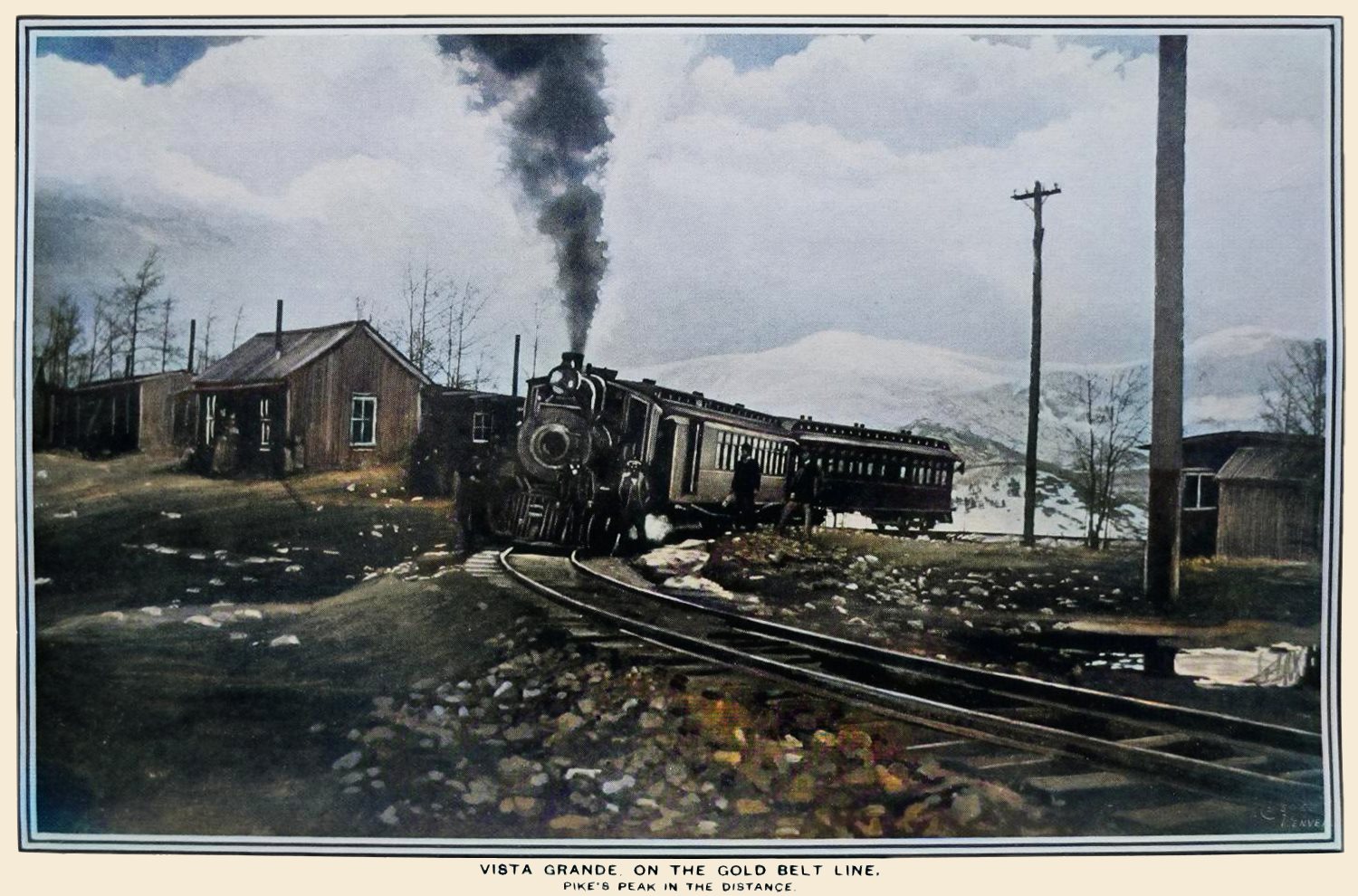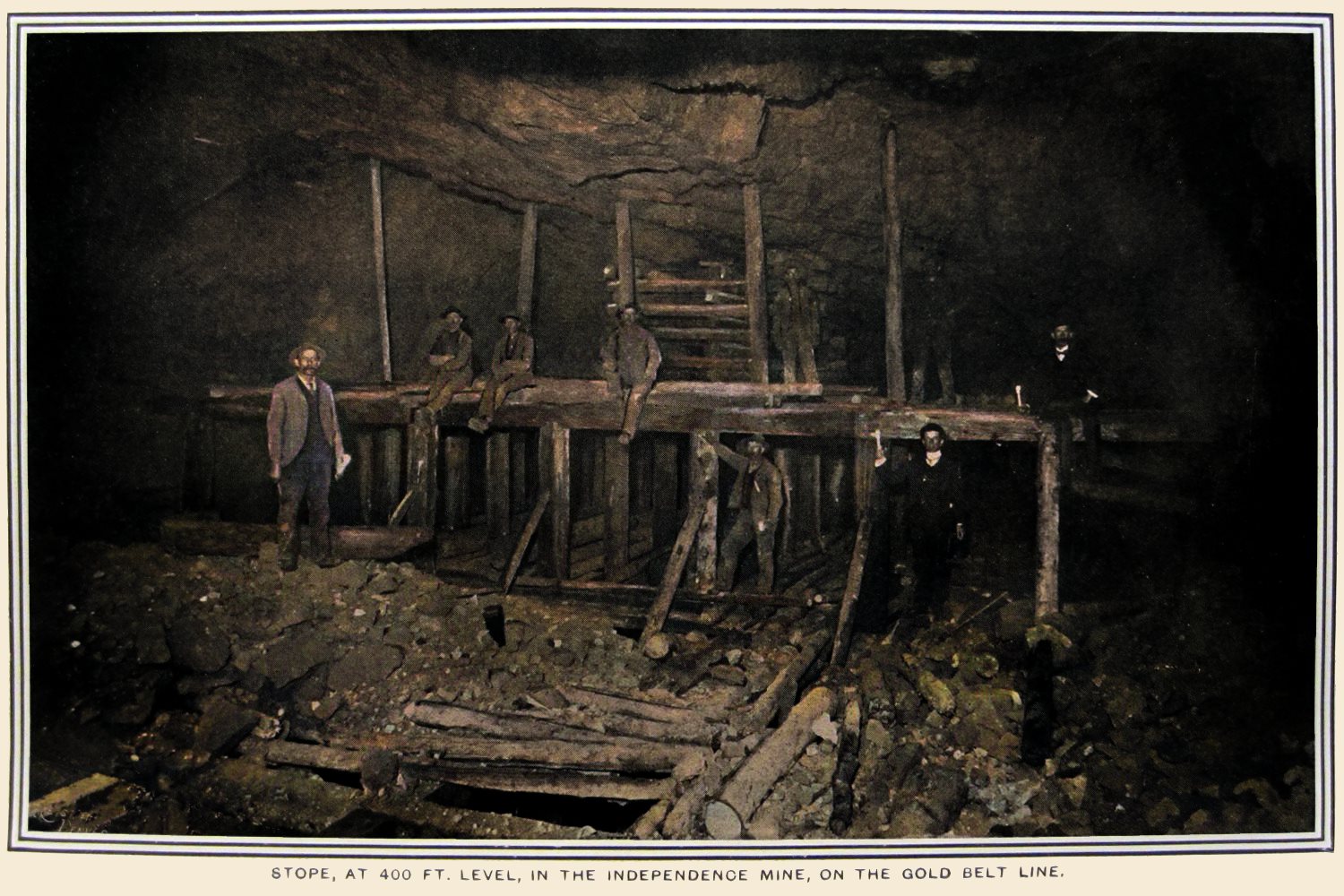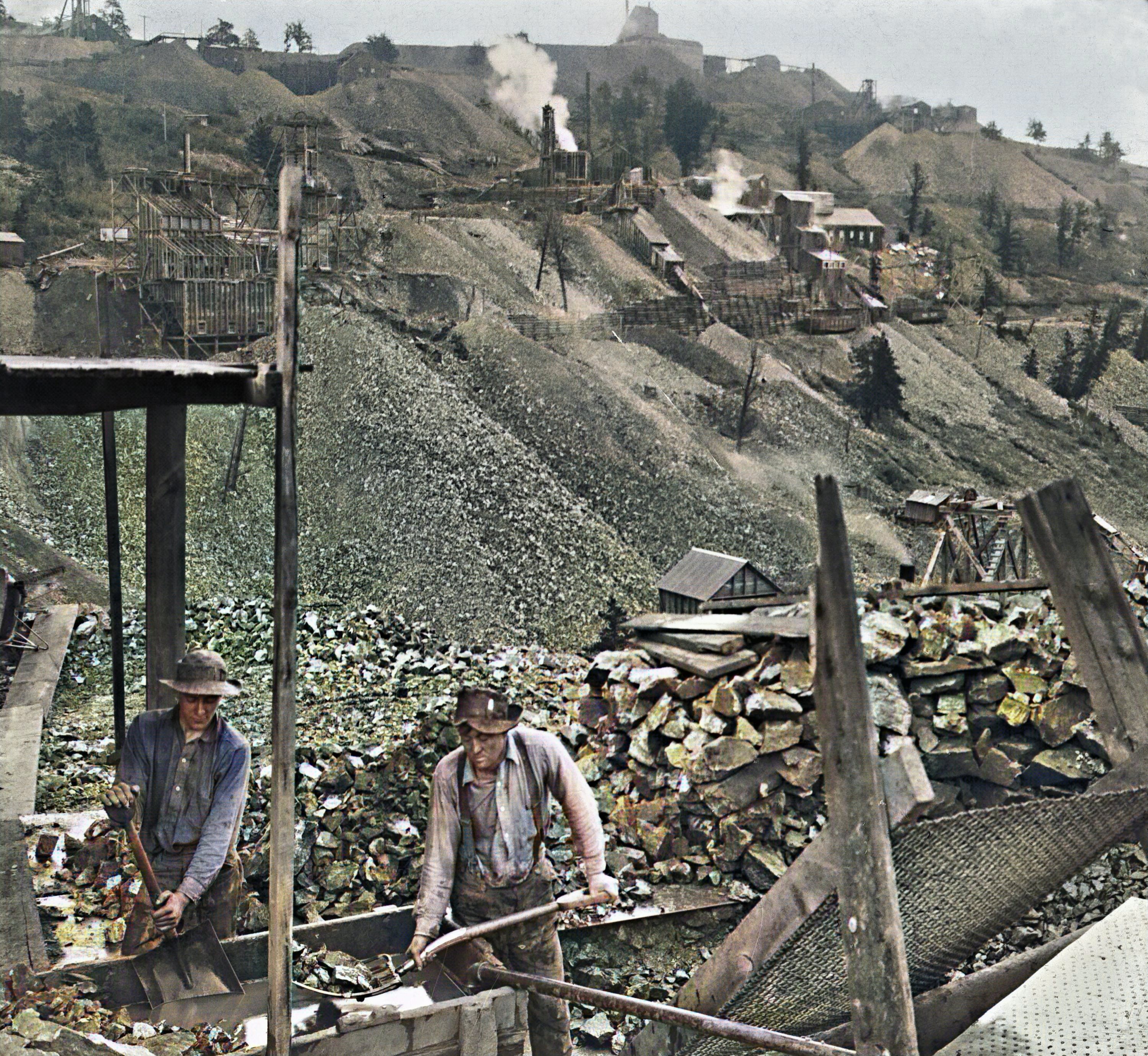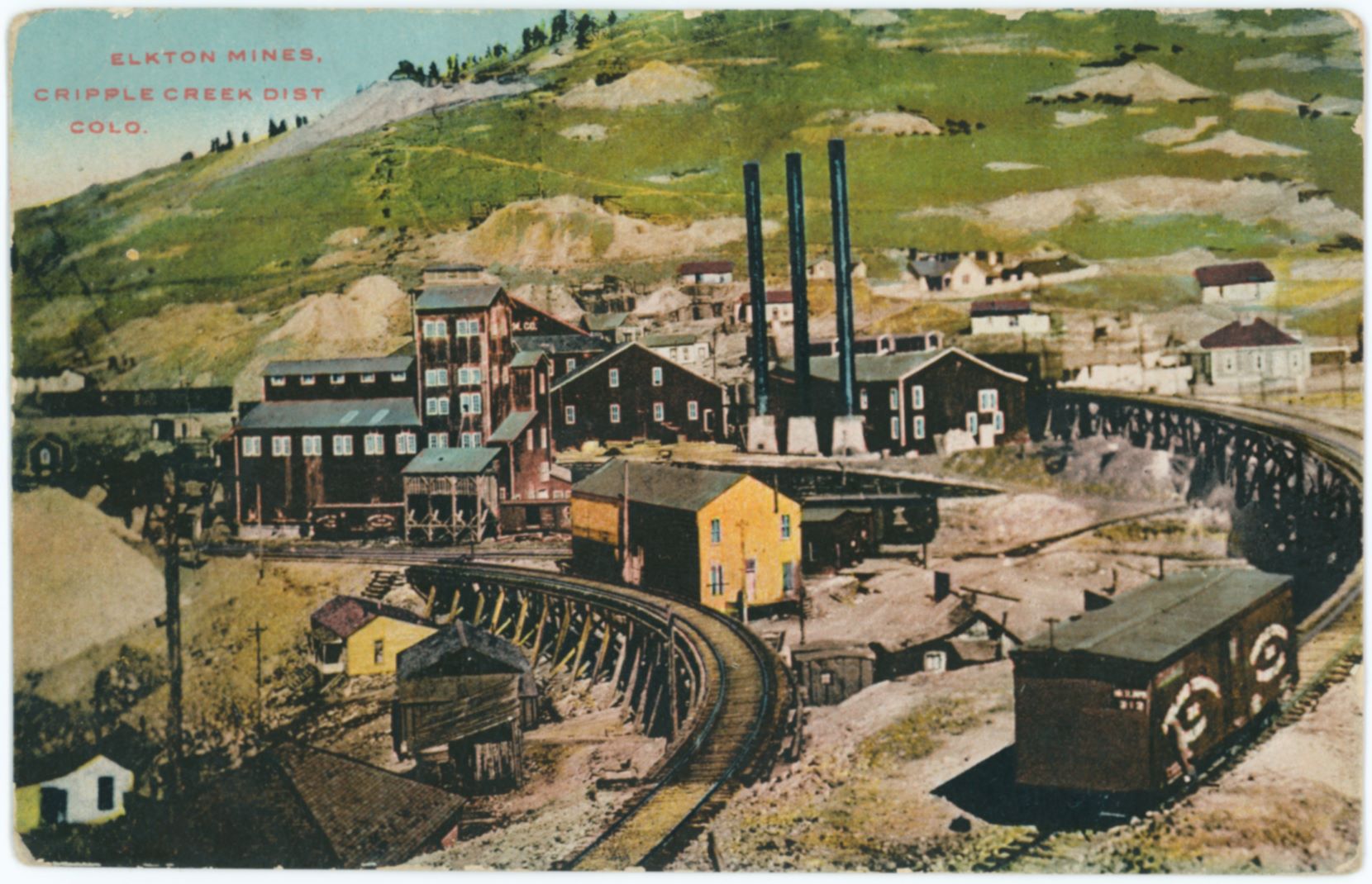-> My Collection; No source to show as I've not shared the Mining Journal as an album.
But, here is a link to first page on Hathi Trust Digital Library website.
August 31, 1905
(page 210—>211)
Source had no images, so I used some images from my collection.
Since the Cripple Creek district first started upon its gold-producing development in the early nineties the eyes of the mining world have often been turned in wonder toward this diminutive gold camp in the shadow of Pike's Peak.
Small in geographical dimensions, it is by no means small in its standing among the gold-producing camps of the world.
California has its great mother lode, the Black Hills of South Dakota have long been famous through the operations of the great Homestake, South Africa has its Transvaal, and other gold-producing districts have their share of notoriety, yet the Cripple Creek district still remains pre-eminently the high-grade camp of the world and in the eyes of Coloradoans at least "the world's greatest gold camp."
It stands in a class almost by itself, for in very few cases do we find the character of ore which the Cripple Creek district presents, and nowhere else do we find its character and abundance.
Its remarkable development since the first discovery of gold within its borders has been a marvel to the mining public.
Reports of rich strikes within its borders have become so common as to create little more than passing interest. As a matter of fact a great many of the so-called rich strikes noted in the newspapers are either prevarications or exaggerations of the truth; nevertheless, the truth it-self is remarkable.
The El Paso and W. P. H. are examples of late notoriety in the matter of rich strikes. These mines are, however, of comparatively small importance beside some of the larger mines of the district, although the El Paso ranks high as a dividend payer and has a large out-put to its credit.
The metallurgical conditions of the camp have undergone great changes since the district first became important as a gold producer, yet the total expenses of mining and milling have as yet seldom been reduced much below a cost of $16 per ton of ore treated. It will thus be seen that what in some localities would be considered a fairly high-grade proposition is here scarcely deemed worthy of notice.
The average tenor of all the ore shipped from the district is said to be between $30 and $40 per ton, while individual shipments have risen as high as $50,000.
While at first sight the high cost of mining and milling would seem to be a disgrace to the ability of the metallurgical and mining engineer, one does not need to look far to find why such conditions exist. Several causes at once present themselves.
First, the high cost of labor. The lowest wage paid to even the most unsophisticated miner in the district is $3 for an eight-hour day, and ranging from this to $4 for machine men and $5 for shift bosses. While this is not higher than the wage scale in some other camps, it is above the general average.
Second, the high cost of timbering. The Cripple Creek district can boast of but little timber of its own and high transportation charges render the cost of timbering a considerable item of expense. However, this is compensated for somewhat by the general hard character of the rock, which does not as a rule call for an excessive amount of timber.
Third, the general condition of ore occurrence.
Fourth, the peculiar metallurgical conditions of the Cripple Creek ores.
With regard to the first two items enumerated above, there would seem to be but little chance for a saving in expense. A reduction of wages, while possible and even a condition which might present itself in the future history of the camp, is not a matter to be looked upon with favor by one who believes that the laborer is a man whose condition is worthy of more than passing notice.
We believe that the man who faces the unavoidable dangers of underground work is well entitled to his reward.
The cost of timbering does not seem likely to be reduced unless it should be through methods of mining requiring less timber for the support of the walls.
This would in many cases be possible by stoping from one level to another, removing the ore and them allowing the walls to cave. This introduces other difficulties, however, in the shape of the unstable character of the surrounding ground and uncertain surface conditions and would not in most cases seem advisable.
It would seem, therefore, that if a reduction of expenses on Cripple Creek ores is to be hoped for, it must be through the reduction of the expenses incident to the last two difficulties enumerated above.
Let us discuss first the general condition of ore occurrence and its bearing upon the high cost of mining. Messrs. Lindgren and Ransome in the preliminary report of the geological re-survey of the Cripple Creek district, recognize two main types of ore deposits.
First - Tabular in form and following simple fissures or sheeted zones.
Second - Irregular bodies adjacent to fissures and formed by replacement and recrystallization of the country rock.
The first form of deposit is much the more common and the veins are probably better described as sheeted zones than true fissure veins. The openings for the deposition of ore have in most cases been very narrow and the intervening rock between the small fissures in the zones of fracture are seldom permeated to any great degree with the gold-bearing minerals.
This fact introduces at once one of the chief causes of the high cost of mining. The entire sheeted zone will seldom pay to break and ship entire, but the conditions of the ore occurrence render it necessary that the whole be broken in order to get at and liberate the valuable mineral contained in the small fissures. It thus follows that for every ton of ore shipped a large amount of waste must be handled. Of course there are exceptions to this rule, especially in granite where the second type of veins enumerated above are more common.
For various reasons it is seldom possible or practicable to leave the waste material underground. In the first place the fine material from the broken rock is the most valuable portion and while it might be possible to screen underground and hoist only the under-size, this practice is not in most cases commendable.
It has, however, been practiced in some mines to a greater or less extent. The sorting of the oversize underground can only be done under very unfavorable conditions and is seldom undertaken.
The fact remains that whether sorting be done underground or on the surface a great deal of waste must be handled and it has been found to be more economical to hoist the entire product and do the screening and sorting upon the surface.
This leads to an intermediate phase between the mining and metallurgical departments, that of the separation of the ore and waste. In most types of deposit some form of mechanical concentration can be adopted, but so far no form has been found that would meet the requirements of the Cripple Creek ores.
Water concentration is impossible from the fact that the common gold mineral, calaverite, is so readily comminuted that it escapes with the lighter gangue material.
The methods of washing and sorting the Cripple Creek ores have been considered in other articles and will not here be given in detail.
The method employed at the Elkton mine will serve as a sample of the most efficient practice and is as follows:
First - Ore from mine screened to about three-fourths inch. Undersize direct to ore bin. Oversize over picking table to crusher. On the table the coarser waste is picked out by hand and passed to a revolving washer where the fines are washed off and saved.
Second - Remainder of oversize goes to Blake crusher.
Third - From crushes through revolving washer.
Fourth - From washer to endless belt, where waste and ore are separated by hand.
As may readily be surmised, a considerable amount of valuable material must of necessity pass out with the waste, the tenor of the whole being, however, too low to be of value.
It will thus be seen that while the cost of ore sorting as employed at present is a rather expensive operation, it is upon the whole a very unsatisfactory one. The difficulties in the way of a mechanical separation seem insurmountable yet, as the saying is "necessity is the mother of invention" and we believe that the necessity of falling back upon lower grade material which at present can not be handled at a profit will in time lead to a more efficient method of ore concentration.
Less waste in the ore pile and less ore in the waste pile is a condition much to be desired and the problem would seem worthy of careful study and experimentation.
The methods of treating Cripple Creek ores have been too often described to need repetition here.
Amalgamation, practiced to some extent in an early day, is no longer thought of, although some of the ore is amenable to this treatment.
Chlorination, cyanidation and smelting are the three methods generally employed, with chlorination at the head of the list as regards tonnage treated.
Either of the leaching processes requires roasting for the telluride ores previous to their treatment, and usually concentration of the coarse gold after leaching. Considerable expense thus attaches to either method. A great deal of experimental work has been done looking toward the leaching of telluride ores without roasting, but so far without practical result.
It is claimed, however, that a successful method has been found, but until it is put in operation on a practical working scale the result cannot be accepted as anything more than a possibility.
We have heard a prominent mill man who claims to have a method of treating refractory ore say that it would not be long before expenses for treatment would be reduced to $1.50 per ton.
In this connection it is interesting to note that oxidized ores are now being mined and milled in the district at a cost of only 75 cents per ton exclusive of interest on capital invested. This should not, however, be considered as bearing upon the possibilities of treatment of the ordinary refractory ores.
Considerable discussion has taken place of late with regard to the future possibilities of the Cripple Creek district. Such discussion has generally been based upon the amount of ore in sight and the probabilities of new discoveries. Upon such considerations it seems quite probable that Cripple Creek has already passed its halcyon days and that the production of 1900 will never be materially increased.
Many once-highly-productive mines have already passed to the relics of by-gone days, and many more must inevitably soon follow.
We believe, however, that Cripple Creek has other important leases of life outside of its reserves of high-grade ore and that these factors will have a very important bearing in the camp's future development. Among these the following three items seem to be of considerable importance and worthy of consideration:
First - The possibility of mechanical concentration of telluride ores.
Second - The possibility of simpler and cheaper methods of treatment.
Third - The more extensive application of simple cyanidation to ores amenable to this treatment.
The days of high-grade with its fascinating possibilities must slowly pass to be replaced by a day when metallurgical achievements shall have overcome the difficulties which now act as a drawback to the camp's advancement.



